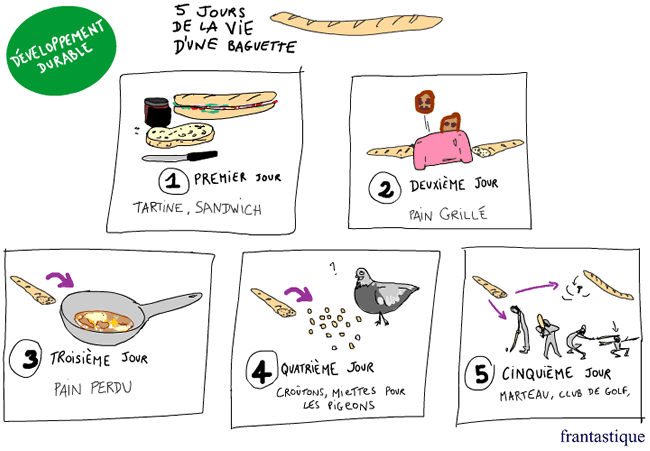The best-known type of French bread is the baguette, which was possibly introduced to France in the early 19th century by August Zang from Austria, though that’s another story.
Baguettes only stay fresh for a day, so what do you do with them once they start to go hard?
Here are a few possibilities:

Here’s a translation:
1. First Day: sliced with butter, sandwich
2. Second Day: toast
3. Third Day: French toast (“lost bread”)
4. Fourth Day: croutons, crumbs for the pigeons
5. Fifth Day: hammer, golf club
Image supplied by Frantastique, who can teach you all about the bizarre French cuisine, and help you to learn French.
I was told that if your baguette is a bit stale you can revive it by sprinkling a bit of water on slices and blasting them in a microwave for a short while. I haven’t tried this as I’m am microwaveless.
The French word baguette can also refer to:
– a magic wand = baguette magique; baguette de fée; baguette de sourcler
– chopsticks = baguettes chinoises
– conductor’s baton = baguette de direction; baguette de chef d’orchestre
– a drumstick = baguette de tambour
Expressions incorporating baguette include:
– sous la baguette de … = conducted by …
– faire marcher qn à la baguette = to rule sb with an iron hand
What are baguettes called in your country?
I love the term pain perdu— it makes me think of the bread giving itself up for a greater cause.
Polish language has a functioning word, borrowed from French: “bagietka”. Otherwise, we call it:
1. “weka” (pronounced “veka”) – this is local from Krakow region (southern Poland). “Weka” usually a little wider and bigger than traditional baguette.
2. “bułka paryska” – Parisian white bread
3. “bułka francuska” – French white bread
Simon,
You can “revive” almost any bread by lightly sprinkling with water and baking in for a few minutes in a regular oven. You just can’t do it too long because it will turn into stone. It also has to be eaten right away, definitely do not keep it after it was “revived”. No major need for a microwave.
Hi Simon,
I love your post because I every time found new thing from your post.Bread called in India “roti” or “chapati”.Roti or Chapati is our daily food.Basically it cooks in house in India.
Considering the number of different long thin things it can be applied to, It seems as if “baguette” almost refers to the shape. It’s just that the loaf of bread has become the canonical example of it. It’s kind of like “orange” in English: there are lots of objects that color, but the fruit is so much the standard for the color it has no name other than the color.
Actually, orange was originally the name of the fruit, and the colour was named after it.
6th day onwards: Bread pudding – assuming, that is, you have not already used it to play a round of golf.
In Russia, stale bread is made into a lightly fermented drink called квас ([i]kvas[/i]). That’s usually dark rye bread, though – I don’t know whether using a baguette would work,
“It seems as if “baguette” almost refers to the shape….”
It certainly does – baguette means ‘wand’ or ‘rod’ and probably had this meaning long before it referred to any kind of bread. If you walked into a bakery and asked for ‘une baguette’, of course, it would be understood that you want a loaf of bread; if you asked the same in a music shop, they would assume you were wanting a conductor’s baton (another French word, of course, but not the one commonly used in France in this instance).
Russian “квас”, Polish “kwas” means acid. I think the drink almost have to be made of dark rye bread that was made using the fermented “starter” and not yeast. Way back when (before Coca Cola) in Poland we used to make a drink out of water and yeast with sugar or honey. After shore fermentation process, you would get a bubbly drink.